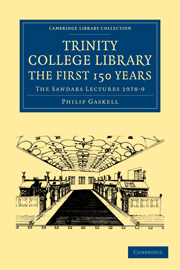Book contents
- Frontmatter
- Contents
- Lists of illustrations and plans
- Preface
- Terms and conventions
- Abbreviations
- 1546–1600
- 1601–1695
- 9 The New Library
- 10 Stanhope's Librarianship
- 11 Collections of manuscripts
- 12 The growth of the working collections, 1601–40
- 13 The arrangement of the books, 1601–40
- 14 Administration and reorganisation, 1641–74
- 15 The book stock, 1667–95
- 16 The last years of the New Library
- APPENDIXES
- Index
12 - The growth of the working collections, 1601–40
Published online by Cambridge University Press: 05 August 2011
- Frontmatter
- Contents
- Lists of illustrations and plans
- Preface
- Terms and conventions
- Abbreviations
- 1546–1600
- 1601–1695
- 9 The New Library
- 10 Stanhope's Librarianship
- 11 Collections of manuscripts
- 12 The growth of the working collections, 1601–40
- 13 The arrangement of the books, 1601–40
- 14 Administration and reorganisation, 1641–74
- 15 The book stock, 1667–95
- 16 The last years of the New Library
- APPENDIXES
- Index
Summary
Until quite late in the sixteenth century most dons at Oxford and Cambridge needed the use of no more than about a couple of hundred books whatever their subjects. Areas of study, and the books which covered them, were clearly limited; and in general new subjects and the books associated with them were not added to the old ones but replaced them. College libraries, therefore, usually contained between 250 and 500 volumes, while individual scholars could supply most of their own needs with private libraries averaging about 100 volumes.
During the last quarter of the sixteenth century, however, there was an increasing tendency to add new subjects and books to what was there already, rather than to throw out the old to make way for the new. Thus in the mid-century the teaching of the medieval Schoolmen was superseded in the universities by that of later theologians, and their books were removed from the college libraries; but when in the 1590s interest in the Schoolmen began to revive, their books were reintroduced into the college libraries not as replacements for but as additions to the works of the later theologians. Everywhere learning began to expand, and the need for books to expand with it. The college libraries grew steadily larger, and at the same time increased in importance as the need for books began to exceed the capacity of individuals to own enough of them privately.
- Type
- Chapter
- Information
- Trinity College Library. The First 150 YearsThe Sandars Lectures 1978–9, pp. 86 - 91Publisher: Cambridge University PressPrint publication year: 2010First published in: 1980

